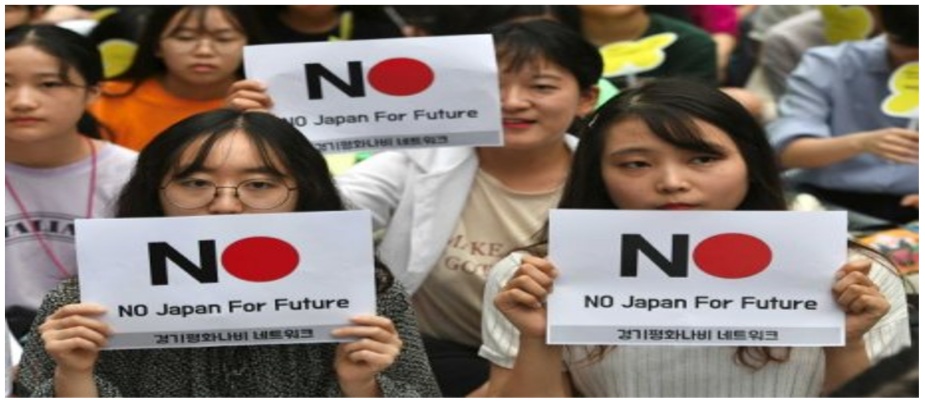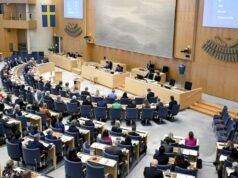Why Japan and South Korea are embroiled in a trade war?

At the heart of the trade dispute between Korea and Japan is the legacy of colonialism.
While the world has been focused on the escalating trade war between China and the US, another economic spat has been bubbling away.
South Korea and Japan, two of Australia’s biggest trading partners, are embroiled in a sour dispute with global implications.
But unlike most trade wars, this isn’t about economics or security.
It is about history and colonialism, and a complex legacy of forced assimilation, slave labour and brutality.
A violent occupation
In the early 1900s Japan began looking for its own imperial possessions. It found Korea.
South Korea and Japan have a relationship stretching back centuries, but their trade dispute relates to the period between 1910 and the end of World War II.
In the early 1900s the Western powers were carving up Asia and Japan, the first Asian nation to modernise, began looking for its own imperial possessions.
It found the Korean peninsula.
“The early stages of Japan’s colonisation of Korea rank among the most brutal of any colonial experience anywhere, and this would include King Leopold’s Congo,” history professor Alexis Duddentells RN’s Rear Vision.
“There were people who protested, there were armed resistance movements, but they were few and far between compared to the organised modern militaries of the Japanese at the time.
“Korea quickly fell in a very violent way to complete Japanese control in 1910.”
‘Subjects of the empire’
Professor Dudden says the colonisation of the peninsula was “total”.
“Japan owned the banks, Japan owned the railways, Japan owned the electricity, they owned the education, they owned the military,” she says.
Ivan Tselichtchev, an expert in Asian economies and history, says Japan “made a lot of effort to bring about Korea’s modernisation”, building new infrastructure like schools and hospitals.
“They wanted to integrate it into Japan, to make it actually part of a new rapidly developing Japan,” he says.
Keijo Imperial University in modern-day Seoul was set up by the Japanese occupying forces in 1924.
JAPANESE GEOGRAPHY AND FOLK CULTURE: VOL.16
But that doesn’t mean Koreans and Japanese were on equal footing.
“Independence or liberation movements were severely suppressed,” Professor Tselichtchev says.
As World War II edged closer, he says, “the assimilation trends amplified”.
“All education in Korean language was banned. Koreans were forced to change their names to Japanese names,” Professor Tselichtchev says.
Slave labour and ‘comfort women’
A statue of a girl symbolising enslaved Korean “comfort women” in front of the Japanese Embassy in Seoul attests to some unresolved history.
At the time Japan entered WWII, Korea was effectively part of Japan.
While some Koreans volunteered to fight for the Japanese army, an estimated 1 million others were forced into slave labour, building weapons for the war machine.
“A lot of these Koreans who were forced to labour in Japanese factories and mines really suffered tremendously,” says history professor Gregg Brazinsky.
“In fact, conditions … were so terrible that there were something like 60,000 Koreans who died while labouring in Japanese factories.”
Tens of thousands of Korean women and girls were also forced into brothels serving the Japanese army; euphemistically called ‘comfort women’.
“A substantial number of Korean women were treated as sex slaves and were forced to entertain Japanese soldiers,” Professor Tselichtchev says.
‘Comfort woman’ on a mission
An Australian used as WWII sex slave is still fighting for justice from Japan.
A post-war split
When the war eventually ended in 1945, the Japanese empire was dismantled and Korea was divided in two.
Soviet troops occupied the North, and US troops controlled the South.
The Republic of Korea was proclaimed in 1948, two years before the South declared independence, sparking a North Korean invasion.
The subsequent Korean War, which lasted from 1950 to 1953, ended with a stalemate that continues to the present day.
Southern Koreans were forced into action at the front line of the Korean War.
Stanford University’s Dan Sneider, a lecturer in international policy, says the US then tried to mend relations between South Korea and Japan.
“The United States was eager to have… its two principal allies at that point … united to some larger security system in north-east Asia, a kind of north-east Asian version of NATO,” he says.
“The Koreans would have nothing to do with that … the memories of the colonial rule and the war were far too fresh and bitter.
“And for the Japanese there was a lot of trouble dealing with the issues of apology and compensation.”
More than a decade would pass before South Korea and Japan established diplomatic relations and began to deal with these difficult questions.
The signing ceremony of the Treaty on Basic Relations between Japan and the Republic of Korea in 1965.
“After 13 years of negotiations, the Americans finally decided that it was time for Japan to pony up and pay some money,” Professor Dudden says.
“This had nothing to do with the history of Korean suffering, but it had everything to do with the United States’ war budget, which wanted to transfer funds from propping up South Korea.
“The United States was 80 per cent of the national budget and 100 per cent of the defence budget of South Korea in 1964, and the United States wanted to transfer those funds for its new effort in Indochina to fight in Vietnam.”
One treaty, two opposing narratives
In 1965 a treaty was made between Japan and South Korea — and experts say it is at the heart of today’s dispute.
“What is absolutely essential to today’s debate is that the 1965 treaty is abundantly clear, the money transferred from Japan to South Korea is not reparations, it’s not compensation — it’s essentially ‘congratulations on your independence’ money,” Professor Dudden says.
As South Korean and Japanese officials attempted to normalise relations, thousands of people demonstrated in Seoul.
Mr Sneider says there are two narratives about the 1965 treaty, and “they don’t agree with each other”.
“In the progressive narrative, the 1965 treaty is an awful unequal treaty imposed in part by the United States,” he explains.
“The South Korean government was the government of Park Chung-hee of the military leadership … and they accepted a settlement that in no way dealt with the real compensation for individual victims.
“And the government that is in power today in Seoul, President Moon Jae-in, is a progressive government, and they absolutely embrace this idea that the ’65 treaty is not a legitimate treaty, it wasn’t done by Koreans themselves.”
The conservative narrative, he says, is “quite different”.
“Park Chung-hee … [was] determined to pursue the modernisation and industrialisation of South Korea,” Mr Sneider says.
“He looked to the Japanese not only as a model for how to industrialise but as a source of technology and capital, and that’s what he got out of the 1965 treaty.
“I think most economic historians agree that the massive grants and loans which Japan provided under that treaty … was the seed core for the industrial Korea that we see today, which is one of the leading modern industrial nations of the world.
“So the conservative view is ‘No, this wasn’t an unequal treaty, we just made the choice to take the money that Japan gave us and use it for this purpose rather than individually compensating victims’.”
The struggle to make peace with the past
Student unrest and international pressure in the late 1980s led to South Korea’s first free parliamentary election in 1988, and the opening up of its society.
“South Korea does move slowly but surely towards greater and greater democracy, greater and greater freedom of speech, freedom of the press,” Professor Brazinsky says.
“One of the by-products of this was that Koreans become more comfortable with talking about what had happened under Japanese colonialism, and became more comfortable with criticising different aspects of Japanese rule and demanding that some aspects of Japanese colonialism that hadn’t been addressed get addressed.”
Throughout the 1990s, Japanese officials offered a number of apologies for war-time atrocities, but they were never quite enough for Koreans.
“Probably the benchmark is the 2010 Kan Naoto 100th anniversary of the annexation statement,” Professor Dudden says.
It saw then-Japanese prime minister Naoto Kan offer a renewed apology to South Korea for the brutal colonial rule.
Professor Dudden says the statement also exposed divisions in Japanese society over how to make peace with its past.
“Not only does [Mr Kan] address past history but he also asks the Japanese to understand on a deeper level that Koreans really were injured by having their ethnicity stripped from them,” Professor Dudden says.
“And that’s what makes what’s going on to me less about Korea versus Japan, which is easy to do in black-and-white terms, but more about Japan versus Japan.
“There are deep divisions in Japanese society over how to address Japan’s imperial era. And Korea is maybe the fiercest example because this is the closest neighbour, the deepest history.”
In the 1990s, Japan “began to recognise the truth publicly”.
“The history of forced labour, not only in Korea but empire-wide, began to be included in Japanese middle school textbooks, high school textbooks,” Professor Dudden says.
“The Kono statement of 1993 promised would happen in perpetuity — that Japanese children would forever be educated in these histories so that they would not happen again.”
But since then, she says, that “has taken a dramatic about-face”.
“These histories have been strategically removed from textbooks, and the opposite was put in,” Professor Dudden says.
“We are back to a kind of history that appeared in Japanese textbooks in the 1960s which was equivalent to saying, ‘Oh well, Japan had no choice because we just had to do what everybody else was doing’.”
A trade war erupts
Last year, a South Korean court ruled that Koreans could sue Japanese companies for damages suffered during the war time period.
Those companies include Nippon Steel and Mitsubishi Heavy Industries, one of the world’s largest conglomerates.
“The South Korean court ruled in favour of three elderly plaintiffs, and the court awarded roughly $80,000 in compensation,” Professor Dudden says.
She points out that that’s a drop in the bucket — “a weekend at a golf tournament” — for these companies.
“So we are not talking about breaking the industry,” she says.
Professor Brazinsky says for most Koreans, it’s not about money.
“They want some acknowledgement of their suffering — from both the South Korean government and from Japan, and from the Japanese companies that inflicted this,” he says.
But in response to the court ruling, Japanese government and business collectively pointed to the past.
“[They said] ‘No, 1965 settled all that’,” Professor Dudden says.
South Korean lawyers then moved to seize the assets of Japanese firms affected by the ruling.
Japan responded by removing South Korea from its white list of most favoured trading nations.
South Koreans citizens responded by refusing to buy Japanese goods, and protesting.
“Japan claims that its decision to remove South Korea from the white list of most favoured economic partners is related to security concerns, but I haven’t seen any credible evidence of that,” Professor Brazinsky says.
“I think the timing of these decisions to start retaliating against South Korea economically is of course very suspicious because it comes right on the heels of these decisions by the South Korean courts.”
Professor Dudden agrees the current trade war has “nothing to do with economics and security”.
“This has everything to do with differing positions over how to interpret the history of pre-1945 Japan and Korea relations, which unfortunately in of themselves have become security threats in an already volatile environment,” she says.
What will prove the salve this time around remains to be seen.



